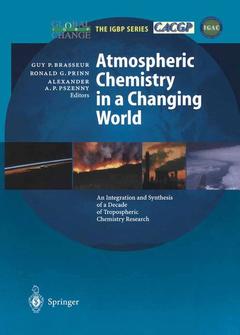1 Changes in the Chemical Composition of the Atmosphere and Potential Impacts.- 1.1 Introduction.- 1.1.1 Atmospheric Chemistry and Life on Earth.- 1.1.2 Environmental Issues and Atmospheric Chemistry.- 1.1.3 The Atmosphere in the Earth System.- 1.2 Global Atmospheric Chemistry and the IGACProject.- 1.3 Past Changes in Atmospheric Chemical Composition.- 1.3.1 Long-Term Variability: Evidence of Feedbacks.- 1.3.2 Changing Atmospheric Composition During the Last FewCenturies.- 1.3.3 Future Changes in Atmospheric Composition.- 1.4 Causes of Atmospheric Changes.- 1.4.1 Fossil Fuel Combustion and Industry.- 1.4.2 Biomass Burning.- l.4.3 Land-Use Changes.- 1.4.4 Climate Changes.- 1.5 Impacts of Changes in Atmospheric Composition.- 1.5.1 Climate Change.- 1.5.2 Impacts on Ecosystems.- 1.5.3 Corrosion.- 1.5.4 Health Effects.- 1.6 Some Important Questions.- 2 Biosphere-Atmosphere Interactions.- 2.1 Introduction.- 2.2 KeyBiogenicGasesor Familiesand their Relevance to Atmospheric Chemistry.- 2.2.1 The Carbon Family of Gases: CH4, Volatile Organic Carbon Compounds (VOCs), and Carbon Monoxide (CO).- 2.2.2 The Nitrogen Family of Gases: Ammonia (NH3), N2D, and NO.- 2.2.3 The Sulphur Family: Dimethylsulphide and Carbonyl Sulphide.- 2.3 A Paleoclimatic Perspective on CH4 and DMS.- 2.4 Atmospheric Compounds as Nutrients or Toxins.- 2.5 Approaches for Studying Exchange.- 2.6 Terrestrial Highlights.- 2.6.1 Exchange of Trace Gases and Aerosols from Terrestrial Ecosystems.- 2.7 Background: Emissions and Deposition.- 2.7.1 Production and Consumption of CH4.- 2.7.2 Biomass Burning.- 2.7.3 Wet Deposition in the Tropics.- 2.8 Marine Highlights.- 2.8.1 Air-Water Gas Exchange Parameterisation.- 2.8.2 Marine Biogenic Emissions: A Few Examples.- 2.8.3 Biological and Chemical Impacts of Atmospheric Deposition on Marine and Estuarine Systems.- 2.9 Summary of Achievements and Remaining Research Challenges.- 3 Atmospheric Photooxidants.- 3.1 Introduction.- 3.1.1 Background.- 3.1.2 Chapter Structure.- 3.2 Ozone Precursors.- 3.2.1 Introduction.- 3.2.2 Primary Emissions of Ozone Precursors.- 3.2.3 Global Distribution of Ozone Precursors.- 3.3 Photochemistry in the Troposphere.- 3.3.1 Background.- 3.3.2 IGACActivities Related to Testing the Theory of HOx Photochemistry.- 3.3.3 Measurements of Total Peroxy Radicals (HO2 + RO2).- 3.3.4 Measurements of Ozone and Peroxide Climatologies in Clean Air.- 3.3.5 Reactive Nitrogen Chemistry.- 3.3.6 The Role of Tropospheric Chemistry in the Production of Part iculate Matter in the Troposphere.- 3.3.7 Modelling of Radical Chemistry and Ozone Production and Loss.- 3.3.8 Progress in Modelling the Global Budget of OH.- 3.3.9 Night Time Free Radical Chemistry - NO3.- 3.3.10 Halogen Chemistry in the Troposphere.- 3.4 Transport and Mixing Processes.- 3.4.1 Boundary Layer Mixing and Exchange.- 3.4.2 Convection.- 3.4.3 Synoptic Scale Transport.- 3.4.4 Stratosphere-Troposphe re Exchange.- 3.5 A Climatology of Tropospheric Ozone.- 3.5.1 Factors Controlling the Global Distribution of Ozone.- 3.5.2 Global Measurements of Ozone and Sonde Data.- 3.6 Long-Range Transport of Pollution and Impact on the Ozone Budget.- 3.6.1 Introduction.- 3.6.2 Continental Pollution.- 3.6.3 North Atlantic Ocean Field Campaigns.- 3.6.4 Pacific Ocean Field Campaigns.- 3.6.5 Studies of Aircraft Emissions.- 3.7 Summary of Principal Achievements and Remaining Uncertainties.- 3.7.1 Achievements.- 3.7.2 Uncertainties.- 4 Tropospheric Aerosols.- 4.1 Introduction.- 4.2 Integrated View of the Present State of Knowledge of Atmospheric Aerosols.- 4.2.1 Space-Borne Measurements.- 4.2.2 In situ Measurements.- 4.2.3 Process Understanding.- 4.2.4 Large-Scale Aerosol Models.- 4.3 Selected Recent Developments.- 4.3.1 Primary Emissions.- 4.3.2 Emissions of Particle Precursors.- 4.3.3 Formation, Evolution, and Removal of Condensed Material.- 4.3.4 Effects of the Aerosol on Radiation in the Atmosphere.- 4.3.5 Effects of Aerosols on Atmospheric Photochemistry.- 4.3.6 Aerosols and Health.- 4.4 Research Approaches.- 4.4.1 In situ Observations with Intensive Campaigns.- 4.4.2 In situ Observations Using Long-Term Monitoring Networks.- 4.4.3 Remote Sensing of Aerosols.- 4.4.4 Aerosol Modelling.- 4.5 Highlights and Remaining Challenges.- 4.5.1 Characterisation of the Atmospheric Aerosol.- 4.5.2 Formation and Growth of Particulate Matter.- 4.5.3 Aerosol-Cloud Interactions.- 4.5.4 Modelling Challenges.- 5 Advances in Laboratory and Field Measurements.- 5.1 Introduction.- 5.2 Laboratory Studies.- 5.2.1 Recent Advances.- 5.2.2 Future Needs.- 5.2.3 Summary.- 5.3 Field measurements: Gas Phase.- 5.3.1 Recent Advances.- 5.3.2 Techniques for the Measurement of Isotopes.- 5.3.3 Use of Lidar on Airborne Chemistry Missions.- 5.3.4 Flux Measurements.- 5.3.5 Instrument Intercomparisons.- 5.3.6 Future Needs.- 5.4 Field measurements: Aerosols.- 5.4.1 Chemical Analysis of Aerosol Samples.- 5.4.2 Particle Number Concentration.- 5.4.3 Number Size Distribution.- 5.4.4 Optical Properties.- 5.4.5 Hygroscopicity.- 5.4.6 Aerosol Deposition Fluxes.- 5.4.7 Issues in Aerosol Sampling.- 5.4.8 Summary of Future Needs.- 5.5 Satellite Instruments for Tropospheric Chemistry.- 5.5.1 Introduction.- 5.5.2 Recent Advances.- 5.5.3 Future Trends.- 5.5.4 Summary.- 5.6 Long-Term Measurements.- 5.6.1 Introduction.- 5.6.2 Global Networks.- 5.6.3 Summary and Future Trends.- 5.7 Summary and Conclusions.- 6 Modelling.- 6.1 Introduction.- 6.2 Types of Models.- 6.3 Model Components.- 6.3.1 Treatment of Large-Scale Transport.- 6.3.2 Representation of Chemical Processes.- 6.3.3 Input to Chemistry-Transport Models.- 6.4 Model Evaluation.- 6.4.1 Comparisons with Observations.- 6.4.2 Model Intercomparisons.- 6.5 Model Applications.- 6.5.1 Evolution of the Composit ion of the Troposphere.- 6.5.2 Use of Photochemical Models for Supporting Field Campaigns.- 6.5.3 Climate Assessments.- 6.6 Current Developments and Future Challenges.- 6.6.1 Further Development of Current CTMs.- 6.6.2 Chemical Data Assimilation.- 6.6.3 Inverse Modelling.- 6.6.4 Dynamic Aerosol Modelling.- 6.6.5 Nesting-Variable Resolution.- 6.6.6 Cloud-Resolving Chemical Models.- 6.6.7 Coupled Earth System Models.- 7 An Integrated Viewof the Causes and Impacts of Atmospheric Changes.- 7.1 Introduction.- 7.2 What Determines the Chemical Composition of the Atmosphere?.- 7.3 How Have Human Activities Altered Atmospheric Composition?.- 7.4 How Have Human Activities Changed the Global Atmospheric Budgets of Carbon, Nitrogen, and Sulphur?.- 7.5 What Controls Tropospheric Ozone?.- 7.6 Is the “Cleansing Efficiency” of the Atmosphere Changing?.- 7.7 How Does Atmospheric Chemistry Affect the Biosphere and Food Production?.- 7.7.1 Impact on Terrestrial and Marine Ecosystems.- 7.7.2 Direct Effects.- 7.7.3 Earth System Feedbacks.- 7.7.4 Impacts on Agricultural Production Systems.- 7.8 How Does Atmospheric Chemistry Affect Human Health?.- 7.9 What is the Connection between Atmospheric Composition and Climate?.- 7.10 How Might Chemical Composition Evolve in the Future?.- 7.11 Are There Risks of Abrupt Changes and/or Irreversible Changes in Atmospheric Composition?.- 7.12 What Should the Research Strategy Be to Address Unresolved Questions?.- References.




